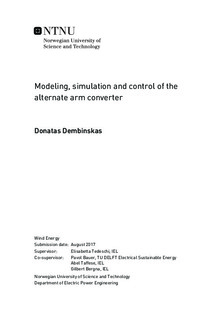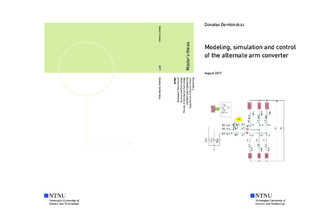| dc.description.abstract | The fast evolving technologies have resulted in an extensive use of the power electronics. More intelligent grids can be made by implementing the power electronic devices. In response to global increasing energy demand and significance of the clean and sustainable future the renewable energy sources, like sun, wind and water are exploited. Power electronic devices together with the renewable energy resources create a new type of grids. The new type of grids create a new challenges. Nowadays more often the new energy production resources are moved outside the land in the seas or the oceans, while the land is used for the accommodation of people. The energy resources moved outside the land require the transmission of the energy, where it is used. Connecting all those three dots: power electronic devices, sustainable and clean future and the new location of the renewable energy sources results in the question how to create the grid for energy transmission and transit the energy in the cheapest and the most sustainable way.
The offshore energy mostly are delivered to the land by the cables. With increasing length of the cable losses increases, in order to avoid losses the AC voltage are transformed to the DC voltage. The transformation of the voltage from AC/DC requires somewhere in the sea or ocean a substation. A substation contains a converter where the all nearby distributed energy resources are connected. The voltage is transformed to DC in these substations. The voltage are transformed again from DC/AC in the next substation usually located onshore. The costs and the reduction of the substation size requires to look for a new and better voltage transformation topology.
In this study a new hybrid voltage source converter based topology is modeled, simulated and controlled. This new topology is usually known as alternate arm converter. For the simulation developing MATLAB/Simulink software is used. With the MATLAB/Simulink software the model of alternate arm converter is developed from the scratch. Firstly the simple one-phase average mathematical model is developed and implemented in the simulation. Then the balancing control between the arms voltages is implemented in the one-phase model. The simple one-phase with a simplified control model is evaluated. Then the three-phase model is created in the same MATLAB/Simulink software. Firstly the three-phase model is evaluated as working in the island mode, which means that it is working alone, not connected to the grid. The improved control is implemented in this 3-phase model in order to increase the performance of the converter. The 3-phase model with improved control model is connected to the grid by using MATLAB/Simulink software. The grid connection is simulated with the voltage sources and phase locked loop control. The phase locked loop constantly adjust the voltage in order to lock onto the phase and frequency. Furthermore it is extract a voltage angle for the used dq0 transformation, which simplifies control. The grid connected model is simulated and evaluated. After this evaluation the MATLAB/Simulink simulation model of the alternate arm converter, together with control is connected in the point to point scheme. The point to point scheme represents the energy transmission from the one point to another or in the different case it can also transmit the energy in the other side. The point to point system is represented in the MATLAB/Simulink model, together with additional droop control, which controls the DC voltage accordingly to the active power. If the active power reaches the maximum value the DC voltage decreases accordingly to the drop value and the way around. The six study cases are simulated in the MATLAB/Simulink software, with the point to point connection. In the first case the operation points are evaluated of the system and the behaviour of the AC voltages, AC currents, DC voltage, arm voltages, arm currents and circulating currents are observed in the terminal 1 and terminal 2, which is AC/DC and DC/AC converters, respectively. The second study case is aimed to inspect the DC side capacitance effect to the DC voltage. In this study case is evaluated that by increasing the DC side capacitance the DC voltage ripple reduces, therefore the AC currents with less harmonic distortions are presented. The third case shows the droop control behaviour for the different drop values. When the drop value is increasing the gain value of the droop control decreases and the smaller deviation of the active power is presented. The forth, fifth and sixth cases arise, because of the problem confronted during the operating point case simulations. The voltages between the upper and lower arms in some of the operating points are not balanced. This issue creates an arm voltage balancing problem, which in the forth study case is solving by increasing overlap time. The observation is made, that by increasing overlap time the balance between the arm voltages becomes better, but the alternate arm converter are forced to approach and change the topology to modular multilevel converter, when the 10 ms is reached in this case. The fifth study case investigates the cell capacitance effect for the arm voltage balance. In this case was found that increasing or decreasing the cell capacitance in the submodules, do not fix the arm voltage balancing problem. This approach makes voltage balance between the arms even worse. The last study case introduces the case of the arm voltage balance technique by using third harmonic current flow together with 1 ms overlap time. This study case requires a minor changes in the point to point system. The results of this technique are evaluated and it shows that this type of the balancing technique is the best technique of the voltage balancing between the arms in this system of the point to point connection. | |

